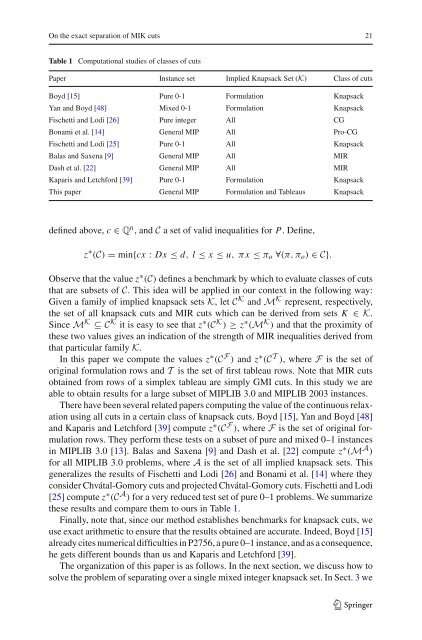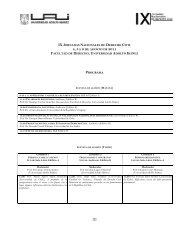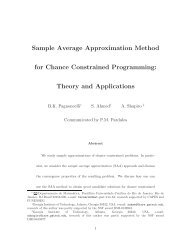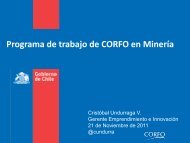20 R. Fukasawa, M. Goycoolea1 IntroductionConsider a positive <strong>integer</strong> n, b ∈ Q, a ∈ Q n , l ∈{Q∪{−∞}} n , u ∈{Q∪{+∞}} nand I ⊆ N := {1,...,n}. In this article we consider <strong>the</strong> <strong>mixed</strong> <strong>integer</strong> <strong>knapsack</strong> setK ={x ∈ R n : ax ≤ b, l ≤ x ≤ u, x i ∈ Z, ∀i ∈ I }.More specifically, we are interested in solving <strong>the</strong> <strong>separation</strong> problem for conv(K ).That is, given a point x ∗ ∈ Q n , we are interested in ei<strong>the</strong>r (a) identifying an inequality(π, π o ) which is valid for conv(K ) (equivalently valid for K ) and violated by x ∗ ,or(b) proving no such inequality exists.By obtaining valid inequalities for <strong>mixed</strong> <strong>integer</strong> <strong>knapsack</strong> sets we can also obtainvalid inequalities for general Mixed Integer Programming (MIP) problems. In fact,consider <strong>the</strong> <strong>mixed</strong> <strong>integer</strong> setP ={x ∈ R n : Dx ≤ d, l ≤ x ≤ u, x i ∈ Z, ∀i ∈ I }.where D is an m × n matrix, and d ∈ Q n .If(a, b) can be obtained as a non-negativelinear combination <strong>of</strong> rows from (D, d), <strong>the</strong>n P ⊆ K and we say that K is an implied<strong>knapsack</strong> set <strong>of</strong> P. If this is <strong>the</strong> case, any inequality which is valid for K will also bevalid for P and we henceforth call it <strong>knapsack</strong> inequality or <strong>knapsack</strong> cut <strong>of</strong> P.Deriving strong <strong>knapsack</strong> inequalities is <strong>of</strong> great practical importance to <strong>the</strong> solution<strong>of</strong> MIPs. In fact, most cutting planes known for general MIPs are <strong>knapsack</strong> <strong>cuts</strong>. Forexample, Gomory Mixed Integer (GMI) <strong>cuts</strong> [30,43] are <strong>knapsack</strong> <strong>cuts</strong> derived from<strong>the</strong> tableaus <strong>of</strong> linear programming relaxations, and lifted cover inequalities [19,34]are <strong>knapsack</strong> <strong>cuts</strong> derived from <strong>the</strong> original rows <strong>of</strong> P. O<strong>the</strong>r classes <strong>of</strong> <strong>knapsack</strong> <strong>cuts</strong>include <strong>mixed</strong> <strong>integer</strong> rounding (MIR) <strong>cuts</strong> and <strong>the</strong>ir variations [17,41,44], split <strong>cuts</strong>[16], lift-and-project <strong>cuts</strong> [8], and group <strong>cuts</strong> [21,31]—to name but a few.In practice, <strong>the</strong> most successful class <strong>of</strong> <strong>knapsack</strong> <strong>cuts</strong> for MIPs are <strong>the</strong> GMI/MIR<strong>cuts</strong> [12]. Dash and Günlük [22] have recently done an empirical study to better understandthis practical success. They show that, in a significant number <strong>of</strong> instances, afteradding GMI <strong>cuts</strong> for all <strong>the</strong> optimal tableau rows, <strong>the</strong>re are no more violated group<strong>cuts</strong> for those tableau rows. Their results are quite surprising, and already suggest howstrong are GMI <strong>cuts</strong> within <strong>the</strong> context <strong>of</strong> group <strong>cuts</strong>.There are, however, natural questions left to answer: In <strong>the</strong> case where <strong>the</strong>re aresome violated group <strong>cuts</strong>, do <strong>the</strong>se <strong>cuts</strong> give any significant improvement in <strong>the</strong> continuousrelaxation bound? In <strong>the</strong> case where <strong>the</strong>re are no violated group <strong>cuts</strong>, are <strong>the</strong>reany o<strong>the</strong>r classes <strong>of</strong> <strong>knapsack</strong> <strong>cuts</strong> that are violated and can yield significantly betterbounds? In fact, S. Dash (personal communication) proposed a closely related conjecturethat for many problems in MIPLIB 3.0 <strong>the</strong> combined effect <strong>of</strong> GMI <strong>cuts</strong> fromdifferent tableau rows is to push <strong>the</strong> resulting solution x into <strong>the</strong> intersection <strong>of</strong> <strong>the</strong>convex hulls <strong>of</strong> <strong>the</strong> <strong>mixed</strong> <strong>integer</strong> <strong>knapsack</strong> sets defined by <strong>the</strong> tableau rows.To help resolve <strong>the</strong>se questions, we empirically assess <strong>the</strong> performance <strong>of</strong> MIRand GMI inequalities relative to that <strong>of</strong> all possible <strong>knapsack</strong> <strong>cuts</strong> using <strong>the</strong> objectivefunction <strong>of</strong> <strong>the</strong> continuous relaxation as a measure <strong>of</strong> quality. Formally, consider P as123
<strong>On</strong> <strong>the</strong> <strong>exact</strong> <strong>separation</strong> <strong>of</strong> MIK <strong>cuts</strong> 21Table 1 Computational studies <strong>of</strong> classes <strong>of</strong> <strong>cuts</strong>Paper Instance set Implied Knapsack Set (K) Class <strong>of</strong> <strong>cuts</strong>Boyd [15] Pure 0-1 Formulation KnapsackYan and Boyd [48] Mixed 0-1 Formulation KnapsackFischetti and Lodi [26] Pure <strong>integer</strong> All CGBonami et al. [14] General MIP All Pro-CGFischetti and Lodi [25] Pure 0-1 All KnapsackBalas and Saxena [9] General MIP All MIRDash et al. [22] General MIP All MIRKaparis and Letchford [39] Pure 0-1 Formulation KnapsackThis paper General MIP Formulation and Tableaus Knapsackdefined above, c ∈ Q n , and C a set <strong>of</strong> valid inequalities for P. Define,z ∗ (C) = min{cx : Dx ≤ d, l ≤ x ≤ u, πx ≤ π o ∀(π, π o ) ∈ C}.Observe that <strong>the</strong> value z ∗ (C) defines a benchmark by which to evaluate classes <strong>of</strong> <strong>cuts</strong>that are subsets <strong>of</strong> C. This idea will be applied in our context in <strong>the</strong> following way:Given a family <strong>of</strong> implied <strong>knapsack</strong> sets K, letC K and M K represent, respectively,<strong>the</strong> set <strong>of</strong> all <strong>knapsack</strong> <strong>cuts</strong> and MIR <strong>cuts</strong> which can be derived from sets K ∈ K.Since M K ⊆ C K it is easy to see that z ∗ (C K ) ≥ z ∗ (M K ) and that <strong>the</strong> proximity <strong>of</strong><strong>the</strong>se two values gives an indication <strong>of</strong> <strong>the</strong> strength <strong>of</strong> MIR inequalities derived fromthat particular family K.In this paper we compute <strong>the</strong> values z ∗ (C F ) and z ∗ (C T ), where F is <strong>the</strong> set <strong>of</strong>original formulation rows and T is <strong>the</strong> set <strong>of</strong> first tableau rows. Note that MIR <strong>cuts</strong>obtained from rows <strong>of</strong> a simplex tableau are simply GMI <strong>cuts</strong>. In this study we areable to obtain results for a large subset <strong>of</strong> MIPLIB 3.0 and MIPLIB 2003 instances.There have been several related papers computing <strong>the</strong> value <strong>of</strong> <strong>the</strong> continuous relaxationusing all <strong>cuts</strong> in a certain class <strong>of</strong> <strong>knapsack</strong> <strong>cuts</strong>. Boyd [15], Yan and Boyd [48]and Kaparis and Letchford [39] compute z ∗ (C F ), where F is <strong>the</strong> set <strong>of</strong> original formulationrows. They perform <strong>the</strong>se tests on a subset <strong>of</strong> pure and <strong>mixed</strong> 0–1 instancesin MIPLIB 3.0 [13]. Balas and Saxena [9] and Dash et al. [22] compute z ∗ (M A )for all MIPLIB 3.0 problems, where A is <strong>the</strong> set <strong>of</strong> all implied <strong>knapsack</strong> sets. Thisgeneralizes <strong>the</strong> results <strong>of</strong> Fischetti and Lodi [26] and Bonami et al. [14] where <strong>the</strong>yconsider Chvátal-Gomory <strong>cuts</strong> and projected Chvátal-Gomory <strong>cuts</strong>. Fischetti and Lodi[25] compute z ∗ (C A ) for a very reduced test set <strong>of</strong> pure 0–1 problems. We summarize<strong>the</strong>se results and compare <strong>the</strong>m to ours in Table 1.Finally, note that, since our method establishes benchmarks for <strong>knapsack</strong> <strong>cuts</strong>, weuse <strong>exact</strong> arithmetic to ensure that <strong>the</strong> results obtained are accurate. Indeed, Boyd [15]already cites numerical difficulties in P2756, a pure 0–1 instance, and as a consequence,he gets different bounds than us and Kaparis and Letchford [39].The organization <strong>of</strong> this paper is as follows. In <strong>the</strong> next section, we discuss how tosolve <strong>the</strong> problem <strong>of</strong> separating over a single <strong>mixed</strong> <strong>integer</strong> <strong>knapsack</strong> set. In Sect. 3 we123
















